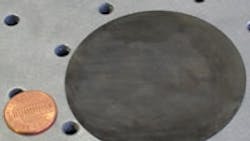For any number of reasons, reducing the amount of waste created in the cutting process is a good thing, but it's particularly important when the material being cut costs more than $600 per pound. That's why a new process of slicing thin wafers of germanium holds promise of reducing the costs of some solar power cells.
The method -- called wire electrical discharge machining -- reduces the amount of waste generated in the actual slicing process as well as breakage of the brittle chemical element, say University of Utah engineers who devised the system for this use. The method, which has been used for machining metals, uses an extremely thin molybdenum wire with an electrical current running through it. Current slicing methods rely on brass-coated, steel-wire saws that cut round wafers of germanium from cylindrical ingots.
Interest in reducing the costs of germanium-based solar cells is spurred by the promise of greater efficiency of these solar power cells over silicon-based solar cells. While silicon-based solar cells on Earth have a maximum efficiency of about 20%, germanium solar cells could convert 40% of sunlight into energy with the use of solar concentrators, according to Grant Fines, chief technology officer for germanium-wafer maker Sylarus Technologies. Sylarus is investigating the use of the university's new method of slicing germanium.
See Also
About the Author
Jill Jusko
Bio: Jill Jusko is executive editor for IndustryWeek. She has been writing about manufacturing operations leadership for more than 20 years. Her coverage spotlights companies that are in pursuit of world-class results in quality, productivity, cost and other benchmarks by implementing the latest continuous improvement and lean/Six-Sigma strategies. Jill also coordinates IndustryWeek’s Best Plants Awards Program, which annually salutes the leading manufacturing facilities in North America.
Have a story idea? Send it to [email protected].

